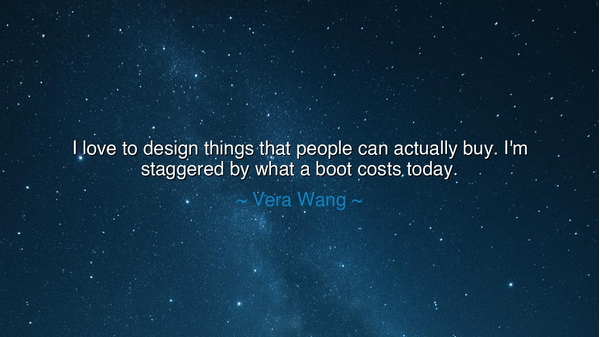
I love to design things that people can actually buy. I'm
I love to design things that people can actually buy. I'm staggered by what a boot costs today.






When Vera Wang declared, “I love to design things that people can actually buy. I'm staggered by what a boot costs today,” she spoke not merely as a designer of luxury, but as a thoughtful observer of the intersection between art, commerce, and accessibility. Her words reveal a deep awareness that design does not exist in a vacuum; it is tethered to society, economy, and the daily lives of those who experience it. For Wang, the thrill of creation is inseparable from the joy of seeing one’s designs reach people, not just adorn them in unattainable fantasies.
The origin of this reflection lies in Wang’s career, where she transitioned from figure skating to fashion design, and ultimately to a career creating bridal wear and ready-to-wear collections. She witnessed firsthand how pricing can elevate objects into symbols of status while also alienating the public. Her astonishment at the cost of a boot underscores her awareness that true design impact is measured not only by elegance or novelty, but by its accessibility, its ability to enrich the lives of those who encounter it. Wang’s passion is rooted in democratizing beauty, finding ways for artistry to meet practicality.
Her insight resonates with the wisdom of the ancients, who often pondered the balance between utility and aesthetics. The Roman architect Vitruvius argued that a structure must embody firmitas, utilitas, venustas — strength, utility, and beauty. Wang’s statement echoes this principle: a boot, like a building, must not only dazzle the eye but serve its wearer, fit into a daily life, and respect the realities of cost. Design without consideration of accessibility risks becoming idle spectacle, admired but never truly lived with or experienced.
Consider the story of Coco Chanel, who revolutionized women’s fashion by creating garments that were both elegant and practical. Her designs freed women from constricting corsets, combining style with wearability. She understood that a design reaches its fullest potential only when it can be integrated into everyday life. Wang channels a similar philosophy: the designer’s joy is multiplied when artistry is paired with practical impact, when beauty can be both admired and possessed.
Wang’s words also speak to the modern tension between luxury and affordability. In a world where fashion often signals wealth and status, the staggering cost of a single boot can overshadow the craftsmanship and creativity behind it. Yet her emphasis on designing for purchase highlights a profound lesson: true design must serve humanity, not merely exalt prestige. A boot that remains unreachable may be admired, but one that can be acquired carries influence, functionality, and meaning into the world.
The meaning of Wang’s reflection extends beyond fashion into every field of creation. Whether in architecture, technology, or art, design achieves its highest purpose when it is accessible and functional, when it connects with the lives of those it is meant to serve. Luxury without engagement may impress, but meaningful design resonates because it meets both aesthetic and practical needs, bridging aspiration with reality. Wang reminds us that creativity must be grounded in empathy for those who experience it.
O listener, take this wisdom into your hands: craft with intention, but measure your creation against its real-world impact. Consider the people who will use, wear, or live with your designs. Let beauty and functionality coexist, and allow your work to be both admired and possessed. By doing so, you honor not only the artistry within yourself, but the humanity of those who encounter it, transforming creativity into a shared experience rather than a distant ideal.
In the end, Vera Wang teaches that design finds its true value in the balance of art, accessibility, and practicality. A boot, like any creation, carries more power when it is not only beautiful but attainable, when it enriches life rather than merely tantalizes desire. Her reflection reminds us that the highest calling of a designer is to create works that inspire, endure, and live in the hands of people — turning vision into reality and elevating the ordinary through thoughtful, human-centered artistry.






AAdministratorAdministrator
Welcome, honored guests. Please leave a comment, we will respond soon